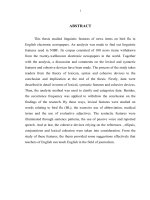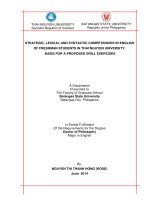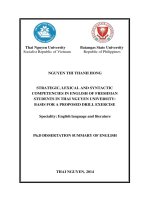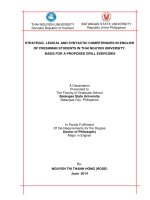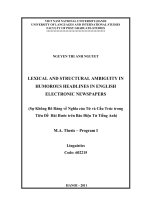Lexical and structural ambiguity in humorous headlines in english electronic newspapers
Bạn đang xem bản rút gọn của tài liệu. Xem và tải ngay bản đầy đủ của tài liệu tại đây (1.54 MB, 11 trang )
Lexical and structural ambiguity in humorous
headlines in english electronic newspapers
Nguyễn Thị Ánh Tuyết
Trường Đại học Ngoại Ngữ
Luận văn ThS. Chuyên ngành: Linguistics; Mã Số: 60 22 15
Người hướng dẫn: Nguyễn Minh Cường M.A
Năm bảo vệ: 2011
Abstract: This study analyzes some forms of linguistic ambiguity in English in a specific
register, English electronic newspaper headlines. In particular, the focus of the research is on
examples of lexical and syntactic ambiguity that result in sources of unintentional humor. The
study is based on a corpus of 52 humorous headlines originating from different electronic
newspapers headlines especially the BBC and the New York Times from 2005 to 2011. The
linguistic phenomena that contribute to create this kind of semantic confusion in electronic
headlines will be analyzed and divided into the two main categories of lexical and structural
ambiguity, and examples from the corpus will be discussed for each category. The result shows
that ambiguity is the source of humor in headlines and it occurs popularly to two fields of
language: lexicology and syntax. On a total of 52 ambiguous headlines, the majority was found
to be ambiguous on a structural level (60. 78percent), while the rest (39.22 percent) presents
some sort of lexical ambiguity. In any case, homonymy, polysymy and the distinctive features of
newspaper headlines which often own loaded words and omit grammar signals are considered
the origin of ambiguity in humorous electronic headlines.
Keywords: Tiếng Anh; Từ vựng; Hài hước; Báo điện tử
Content:
TABLE OF CONTENTS
PART 1 – INTRODUCTION ……………………………… 1
1.Rationale …… …………………………………………… ……. 1
2.Aim of the Study ………………………………………………………………. 2
3.Scope of the Study ………………….…………………………………………. 3
4.Method of the Study ……………… …………………………………………. 4
5.Design of the Study ……………………………………………………………. 5
PART 2- DEVELOPMENT ………………………………… 6
Chapter 1 – Theoretical Background 6
1.1 Ambiguity in English ………………………………………………….……. 6
1.1.1 Concepts of Ambiguity ………………… ………………………….……. 6
1.1.2. Types of Ambiguity …………………………………………………….….7
1.1.2.1 Lexical Ambiguity ………………………………………………………. 7
1.1.2.2 Structural Ambiguity ……………………………………………. …… 9
1.1.2.2.1. Class Ambiguity ………………………………………………. …… 11
1.1.2.2.2 Syntactic Ambiguity …………………………………………….…… .12
1.1.2.3 Phonological Ambiguity ……………………………………………… 12
1.2. Humor in Language …………………………………… ……………….… 13
2.1. Definition of Humor …………………………………….………………… 13
2.2. Context of Humor ……………………………… ………………………….13
Chapter 2: A general Description of Electronic Newspaper Headlines 16
2. 1. Electronic Newspapers ……………………………………………… …….16
2.2. What is meant by Headlines? ………………………….………………….…16
2.2.1. What is a Headline? …………………………………………… …… ……17
2.2.2. The Differences between a Headline and the Headlines …………….… 17
2.3. Functions of Headlines………………………………….……………… ……18
2.4. The Language of Headlines …………………………………………… … 19
2.4.1. The Vocabulary of the Headline Writer ……………… …………………19
2.4.2. Language Devices in Headlines…………………………………………….20
2.4.3. What the Headline Writer Omits ………………………………………….21
2.4.4. How the Headline Writer Reorganizes Language ……………………… 22
Chapter 3: The Study 24
3.1 Methodology …………………………………………… …………………… 24
3.1.1 Samples. …………………………………………… …………………….… 24
3.1.2 Procedure. …………………………………………… ………………….… 24
3.2 Data analysis. …………………………………………… …………… …… 25
3.2.1. Lexical Ambiguity in English Electronic newspapers Headlines .…… 25
3.2.1.1 Nouns …………………………………………… …………………… 25
3.2.1.2 Verbs …………………………………………… ……………………… 28
3.2.1.3. Prepositions …………………………………………… ……………….…30
3.2.2. Structural Ambiguity in English Electronic newspapers Headlines …… .31
3.2.2.1Class ambiguity……………………………………… ……………….…….31
3.2.2. Syntactic Ambiguity ……………………………………… ………… … 33
3.3 Implications. …………………………………………… …………………… 36
PART 3: CONCLUSION……………………………….………….38
1. Major Findings from the Research …………………………….………………38
2. Suggestions for Journalists and Translators ….……………… … …….… 38
2.1 To Journalists ……………………………………………………………… … 38
2.2. To Translators……….…………………………………………………… … 39
3. Suggestions for Teachers and Learners of English in Vietnam … ………… 39
3.1. To Teachers of English. ………………………………………………… … 39
3.2 To Learners of English. ………………………………………………… … 39
4. Suggestions for Further Study ………………….…………………………… 40
REFERENCES
APPENDIX
1
PART 1: INTRODUCTION
1. Rationale
In today’s hectic world one of the most important factors is information. The means of
information provision are quite different which can be summarized in one word: mass media.
The media is the whole body of communications that reach large numbers of the public via
radio, television, movies, magazines, newspapers and the World Wide Web. Conventionally, it
is believed that newspapers have more readers than any other kind of written text. According
to Van Dijk (1986: 156), "for most citizens, news is perhaps the type of written discourse with
which they are confronted most frequently." With the introduction of modern technology and
the emergence of Internet, the traditional newspapers have changed in many ways. In stead of
the only existence of print press, electronic or online newspapers have marked a milestone in
media and become very popular to the public in modern life. It has a variety of forms to
present information ranging from an electronic edition of the printed newspaper, search
engines to search for news topics of interest to news websites which enable the user to browse
items organized in subject categories and sub-categories in given menus. Therefore, electronic
newspapers not only attract internet citizens with their independent forms but also satisfy
readers of traditional press with electronic edition of printed ones.
Among means of language, it can’t be denied that English has become the international
language bridge used dominantly in a large number of electronic newspapers. It makes a great
help in transferring written information from country to country universally. Therefore,
English electronic newspapers not only play a very significant role in broadening knowledge
and culture but also provide a beneficial unlimited source of materials for English learners all
over the world.
It can’t be denied that it is headline, which summarizes the content of a story, and
entices an audience into reading the article, that have the highest readership. According to
Ungerer (2000: 48), "a headline describes the essence of a complicated news story in a few
words. It informs quickly and accurately and arouses the reader's curiosity." Newspaper
headlines are particularly important for the way readers comprehend a news text, “they are
markers that monitor attention, perception and the reading process” (Van Dijk, 1988).
2
Nevertheless, many students of English find that electronic newspaper headlines are especially
difficult to understand. Obviously, it is not just a matter of vocabulary; even the style of
writing is different from any other text they have met in their studies. “The language of
headlines is special and has its own characteristics on the lexical, syntactic, and rhetorical
levels for its brevity, attractiveness, and clarity”(Reah 1998, 14).
The lack of clarity or clearness in the way headlines formed lexically and structurally
creates the biggest obstacle to process of interpretation, even leads to misunderstanding in
many cases. According to Stageberg, “ambiguity is an ever-present peril to clearness of
expression”(1998:501). The existence of ambiguity in electronic newspapers headlines makes
themselves become humorous linguistically.
FARMER BILL DIES IN HOUSE. (From the BBC, October 27, 2009)
Multiple ambiguities exist in the above headline. Bill could be a proper name instead
of 'legislative proposal'; then, depending on the interpretation of the grammatical subject, die
could be taken literally or figuratively and House can be interpreted as home or 'House of
Commons'. Therefore, humorous headlines which readers perceive as funny for the possibility
to interpret them in more than one way have recently become an interesting linguistic
phenomenon on Internet. There are many websites specializing in listing these kinds of
headlines from various online newspapers. For example, the web -with-
words.com/ambiguous_headlines.html, or
However, this thing is usually done for the
sake of entertainment alone and no attempt is made to analyze the linguistic characteristics
that make them humorous. The study is carried out to investigate some main forms of
linguistic ambiguity in a specific register, humorous headlines in English electronic
newspapers.
3
2. Aim of the Study:
The aim of this study is to make an inquiry into the nature of ambiguity in humorous
headlines in English electronic newspapers systematically. The focus of the research is on
examples of lexical and structural ambiguity that result in sources of humor. Therefore, the
research not only presents a scientific description about the ambiguity and gives a satisfactory
explanation about the linguistic characteristics that make English electronic newspapers
headlines humorous.
To achieve this aim, the author will make an attempt to examine the nature of linguistic
ambiguity and explore the notion of humor as well as the context of humor in language. The
distinctive features of electronic newspapers headlines will also be described briefly so as to
give guidelines for analyzing lexical and structural ambiguity in humorous headlines. During
the study process, the following research questions will be raised for investigation:
1. What are linguistic ambiguity and the notion of humor in language?
2. What are the distinctive features of electronic newspapers headlines?
3. How is lexical ambiguity exploited in humorous headlines in English electronic
newspapers?
4. How is structural ambiguity exploited in humorous headlines in English electronic
newspapers?
Through this study, the author would like to provide non-native readers especially
English learners with a profound and appropriate insight into ambiguity which will make a
help for them to eliminate gradually the difficulties in understanding English electronic
newspapers headlines. The study also aims at making some contribution to journalists, to
translators, to teachers and to learners of English in Vietnam by giving some suggestions
basing on the results of the investigation.
3. Scope of the Study
Since “one of the goals of a semantic theory is to describe and explain ambiguities in
words and sentences” (Jame Hurford and Brendan Heasley 1983:121), this study only attempts
4
to investigate lexical and structural ambiguities in a specific register, electronic newspaper
headlines. However, the research does not mention to headlines in general but only a restricted
number of humorous ones from two websites and
which specialize in listing ambiguous
headlines in both British English electronic newspapers and in American English electronic
newspapers during a period of 6 years from 2005 to 2011 are selected to study. Although the
difference of cultures between Great Britain and America can influence differently on the way
the humor is created in headlines, this factor of culture is outside the scope of this study
It is also important to note that the concept of humorous headlines in this study is
interpreted as ambiguous ones which readers perceive as funny for the possibility to interpret
them in more than one way. Therefore, the author of this thesis distinguishes between
headlines containing linguistic ambiguity and those that simply report funny or incredible
stories. However, if linguistic ambiguity created in headlines is writers’ intention is also not
the focus of this thesis.
Within the area of humorous headlines, the study will only focus on a corpus of 52
English electronic headlines selected from the collection available on the two above websites.
4. Method of the Study
As the study set its main objective to be investigating the nature of ambiguity in
humorous headlines in English electronic newspapers, it is explanatory research which begins
with a phenomenon and seeks to describe and explain it. The study is conducted in an
inductive approach where data is collected from English electronic newspapers to describe
lexical and structural ambiguity as a natural linguistic process. To achieve the result of the
research, the author of this thesis focuses on analyzing 52 humorous headlines founded in two
websites and
which specialize in listing ambiguous
headlines in both British English electronic newspapers and in American English electronic
newspapers from 2005 to 2011
5
In the exploration of nature of ambiguity in humorous headlines in English electronic
newspapers, linguistic theory on ambiguity developed by James R. Huford and Brendan
Heasley, Norman C. Stageberg, linguistic theory on language of humor by Alison Ross, the
research on the language of newspapers by Danuta Reah are adopted as the theoretical
framework.
5. Design of the Study
This study is composed of three main parts.
The first part titled “INTRODUCTION” introduces the rationale, the aims the scope
and methodology of the study.
The second part named “DEVELOPMENT” includes three main chapters.
Chapter 1 provides an overview of the theoretical background of the study. Its focus is
on introducing important concepts such ambiguity, types of ambiguity and the notion of
humor in language as well as its context.
Chapter 2 presents a general description of headlines in English electronic newspapers
which deal with the definition of headlines, the functions of headlines and their general
characteristics.
Chapter 3 is the main part of the study which investigates the nature of ambiguity in
humorous headlines in English electronic newspapers. A classification of the different types of
ambiguity founded in electronic headlines and some implications basing on the result of the
study are presented in this chapter.
Part 3 is the CONCLUSION of the study which summarizes the main content of the
research and giving some suggestions for journalists, translators, teachers and learners of
English in Vietnam.
41
REFERENCES
Books
1. Allen &Unwin Vinay, J.P. and Darbelnet, J. (1973), Newspaper Headlines. Londress
2. Alison Ross (2002), the Language of Humor, London and New York: Routledge, pp.
3-40
3. Attardo, S. (1994). Linguistic Theories of Humor. Berlin, New York: Mouton De
Gruyter
4. Didier Ward, M. (2002), Journalism Online, Oxford, Great Britain, pp. 202
5. Dong, Nguyen Thi Van (2001), A Study of Socio-cultural Headlines in English Press,
VNU, Hanoi, PP. 46
6. Fromkin, V.A (1983), An Introduction in Language, Australia Edition, pp. 207
7. Geoffrey Leech (1987) Semantics, Harmondsworth: Penguin Books
8. Hirst, G. (1987). Semantic Interpretation and The Resolution of Ambiguity, Cambridge
University Press
9. James R. Huford and Brendan Heasley (1983), Semantics: A Course Boook, University
Press, Cambridge, pp. 121-148
10. John Lyons (1995), Linguistic Semantics, University Press, Cambridge, pp.55-58
11. Massey, BL & Levy, MR (1999), Interactivity, online journalism, and English-
language Web newspapers in Asia, Journalism and Mass Communication Quarterly,
vol. 76, no. 1, p. 138.
12. McLoughlin, L. 2000. The Language of Magazines. London: Routledge
13. Peter Roach (1983) English Phonetics and Phonology, University Press, Cambridge,
pp. 109
14. Quirk, R., Greenbaum, (1985). A Comprehensive Grammar of the English Language,
Longman, London
15. Reah, D. (1998). The Language ofNewspapers. London and New York: Routledge
16. Steve Sultanoff (1995). Therapeutic Humor, Vol. IX, 3, p. 1-2
17. Stageberg, N. C. (1970), Ambiguity in College Writing, In W. L. Anderson, & N. C.
42
18. Stageberg, N. C. (1971), Structural Ambiguities in English, L. C. Deighton, (Ed.), pp.
232
19. Stageberg, N.C. (1968), Structural Ambiguity in the Noun Phrase, TESOL Quarterly,
Vol. II, No. 4, pp. 232-239
20. Taha, A. K. (1983).Types of Syntactic Ambiguity in English, International Review of
Applied Linguistics in Language Teaching, 21 (4), pp. 251-266
21. Ungerer, F. (2000). English Media Texts - Past and Present Language and Textual
Structure. Philadelphia PA: John Benjamins, pp. 48
22. Van Dijk, T. A. (1986), News Schemata, New York: Dans Cooper and Greenbaum, pp.
156
23. Van Dijk, T. A. (1988), News as Discourse. Hillsdale, NJ, pp. 111
24. Truong, Hoang Tat (1993) Basic English Lexicology, VNU, Hanoi, pp. 89
Websites
